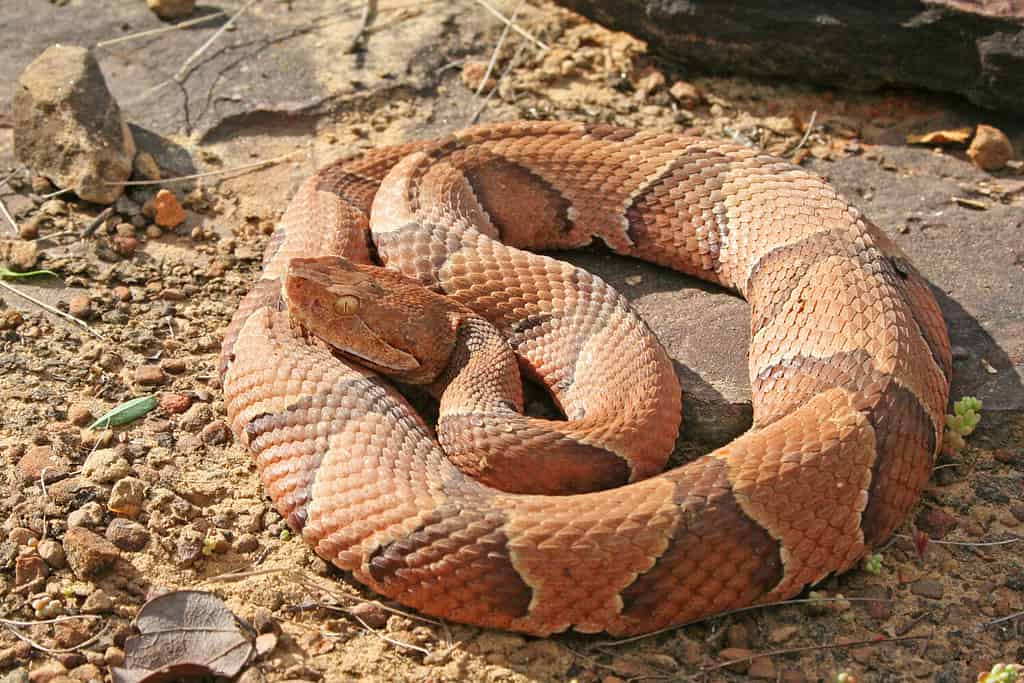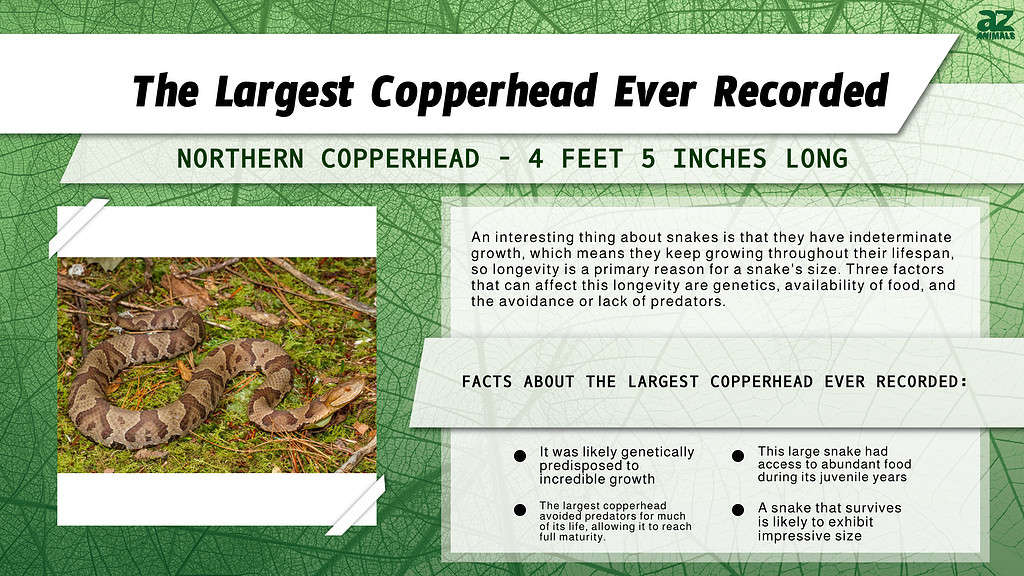Introduction
Animals come in various sizes, but regardless of the typical size, it’s always fascinating to discover an outlier—especially a significantly larger species member. When we come across a huge specimen, it’s reasonable to wonder what made it grow so large. Let’s look at one example—the largest copperhead on record and three reasons it grew so big.
About Copperheads
The copperhead is North America’s most common venomous snake, found in many states in the eastern half of the United States. It is a pit viper, and though it is not as dangerous as some other pit vipers, its bite can still be painful and destructive. It has a distinctive copper color and darker banding along its body. Though there are two distinct species, the eastern copperhead, and the broad-banded copperhead, they are frequently identified as one of five types: northern, southern, Osage, broad-banded, and trans-pecos copperhead. DNA analysis has consolidated these into two species, but people still refer to the abovementioned categories.

Copperheads like this depend on several genetic and environmental factors to reach their full size.
©Creeping Things/Shutterstock.com
The Largest Copperhead Ever Recorded
Although southern copperheads are usually the larger members of the species, the largest copperhead ever recorded was a northern copperhead, recorded by the University of Georgia Extension as being 4 feet 5 inches long! Copperheads, in general, reach lengths of 1½ to 3 feet, so why did this copperhead reach such an extraordinary length? Let’s look at some reasons it grew so large.

The Largest Copperhead Ever Recorded – 3 Reasons It Grew So Large
An interesting thing about snakes is that they have indeterminate growth, which means they keep growing throughout their lifespan, so longevity is a primary reason for a snake’s size. Three factors that can affect this longevity are genetics, availability of food, and the avoidance or lack of predators.
Genetics
Though snakes have indeterminate growth, most of their growth still occurs during their juvenile years. This means that longevity alone does not explain a copperhead’s size. The growth over later years is much slower than in those early years. That means that most of a snake’s size gains occur as juveniles, which, in turn, points to a genetic advantage—some snakes are just genetically destined for superior size. This record-breaking copperhead probably was genetically predisposed to grow so large.
Food availability
Piggybacking onto the discussion of genetic superiority and juvenile growth, studies of some snakes have suggested that an abundance of food fuels the rapid early growth of some species and that this advantage continues into maturity. With this in mind, the availability of prey, such as birds, mice, lizards, and smaller snakes, was probably abundant during the copperhead’s early years.

Avoiding predators
The final element, avoiding predators, ties in with the snake’s longevity. Since snakes have indeterminate growth, a long life contributes to larger size. A snake that survives is likely to exhibit impressive size. Copperheads are most vulnerable to predators when young, so if they make it out of the juvenile stage, they have the potential for further growth during their later years. Natural predators include owls, hawks, kingsnakes, opossums, coyotes, alligators, crows, and cottonmouths. Kingsnakes and opossums are immune to copperhead venom, so these two species continue to be dangerous to the copperhead after the snake’s juvenile years. The largest copperhead avoided predators for much of its life, allowing it to reach full maturity.

Young copperheads are vulnerable to predation by hawks like this one eating a
garter snake
.
©iStock.com/Holcy
So, how does a copperhead grow as large as a park bench? The answer is that it was genetically predisposed to incredible growth, had access to abundant food during its juvenile years, and could avoid predators, allowing it to add years of development onto its adolescent growth spurt. These are the three reasons the largest copperhead on record grew so large.
The photo featured at the top of this post is © Scott Delony/Shutterstock.com
Discover the "Monster" Snake 5X Bigger than an Anaconda
Every day A-Z Animals sends out some of the most incredible facts in the world from our free newsletter. Want to discover the 10 most beautiful snakes in the world, a "snake island" where you're never more than 3 feet from danger, or a "monster" snake 5X larger than an anaconda? Then sign up right now and you'll start receiving our daily newsletter absolutely free.
Thank you for reading! Have some feedback for us? Contact the AZ Animals editorial team.







